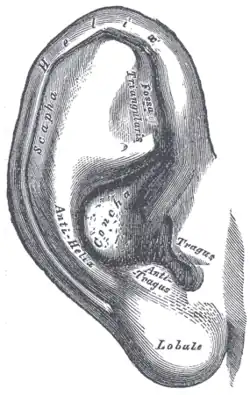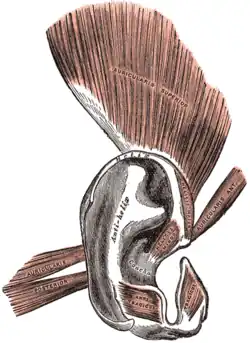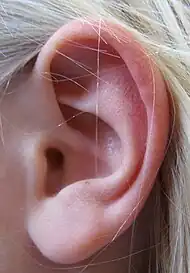Antitragus
| Antitragus | |
|---|---|
 The auricula. Lateral surface. | |
| Details | |
| Identifiers | |
| Latin | Antitragus |
| TA98 | A15.3.01.016 |
| TA2 | 110 |
| FMA | 61001 |
| Anatomical terminology | |
The antitragus is a feature of mammalian ear anatomy.
In humans, it is a small tubercle on the visible part of the ear, the pinna. The antitragus is located just above the earlobe and points anteriorly. It is separated from the tragus by the intertragic notch.
The antitragicus muscle, an intrinsic muscle of the ear, arises from the outer part of the antitragus.[1][2]
The antitragus can be much larger in some other species, most notably bats.
The antitragus is sometimes pierced.[3]
Additional images

 Left human ear
Left human ear External ear. Right auricle.Lateral view.
External ear. Right auricle.Lateral view.
See also
- Antitragus piercing
References
![]() This article incorporates text in the public domain from page 1034 of the 20th edition of Gray's Anatomy (1918)
This article incorporates text in the public domain from page 1034 of the 20th edition of Gray's Anatomy (1918)
- ↑ "Antitragus". AnatomyExpert. Archived from the original on 10 May 2013. Retrieved 9 March 2013.
- ↑ "Henry Gray (1825–1861). Anatomy of the Human Body. 1918". Bartleby.com. Retrieved 9 March 2013.
- ↑ Chandra, Jessica. "It's Time To Consider An Anti-Tragus Piercing". ELLE. Retrieved 2021-07-01.
External links
- Anatomy photo:30:01-0105 at the SUNY Downstate Medical Center
- lesson3 at The Anatomy Lesson by Wesley Norman (Georgetown University) (externalear) (#6)
- Diagram at bodymodforums.com
This article is issued from Offline. The text is licensed under Creative Commons - Attribution - Sharealike. Additional terms may apply for the media files.